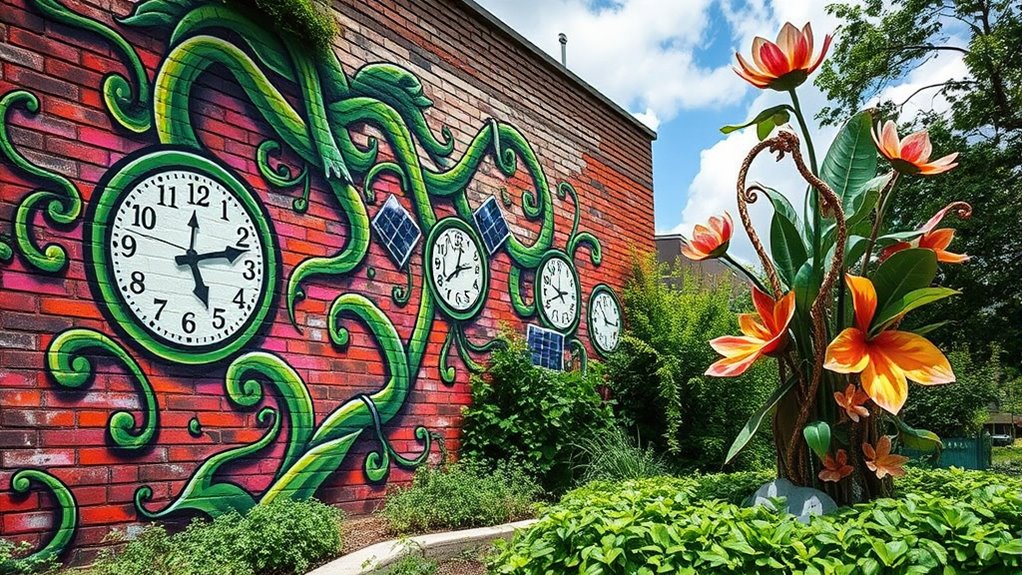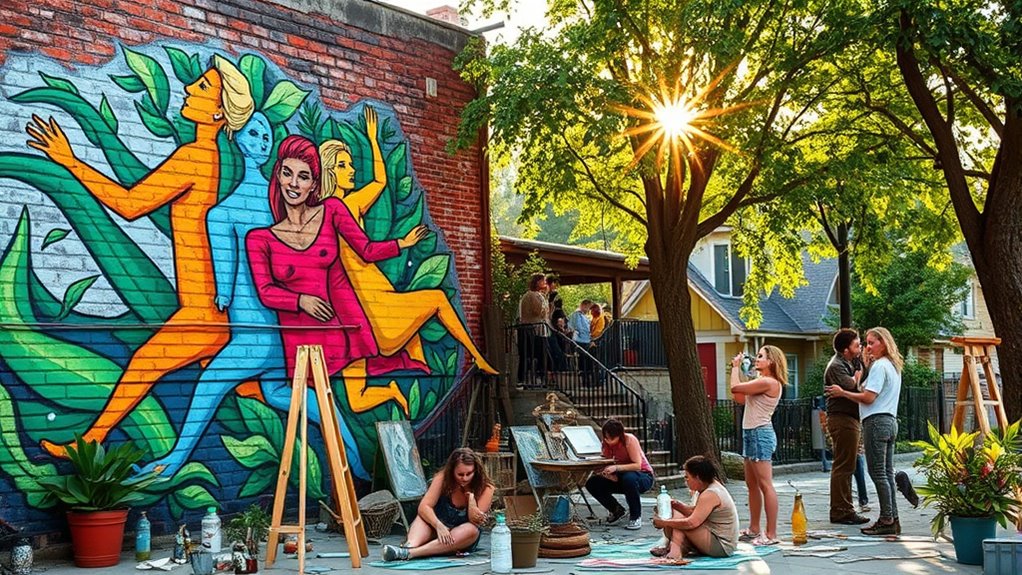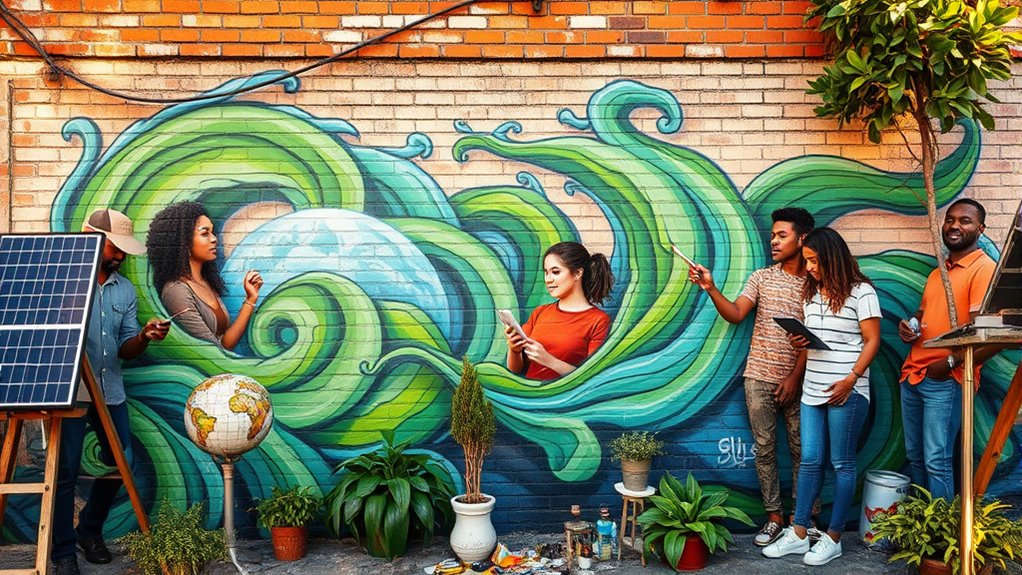In 2025, artists harness eco-contemporary art and digital platforms to spotlight climate justice. They create bold visuals, immersive installations, and interactive online campaigns that inspire awareness and action. Performance and community-based art spark urgent conversations and local change. Challenges exist, but collaborations, new technologies, and innovative funding open doors for impactful activism. Stay with us, and you’ll discover how creative voices continue shaping the fight for our planet.
Key Takeaways
- Artists will leverage immersive installations and recycled materials to vividly illustrate climate justice issues in public spaces.
- Digital platforms will amplify global artivist voices, fostering real-time activism and community mobilization across borders.
- Performance art will intensify emotional engagement, prompting urgent action on climate justice through symbolic live demonstrations.
- Community-led initiatives will center local stories, encouraging residents to co-create solutions and foster sustainable change.
- Emerging technologies and diverse collaborations will overcome challenges, enabling innovative, impactful climate-focused art projects by 2025.
The Rise of Eco-Contemporary Art and Its Impact

Eco-contemporary art has surged in popularity as artists increasingly focus on environmental issues, making their work both visually striking and socially relevant. You’ll notice more pieces that highlight climate change, pollution, and biodiversity loss, capturing attention and sparking conversations. Artists use bold visuals, recycled materials, and immersive installations to communicate urgency and hope. This movement transforms public spaces into platforms for activism, encouraging viewers to reflect and act. The impact is profound: it raises awareness, influences policy, and fosters community engagement. By blending aesthetics with activism, eco-contemporary art inspires collective responsibility. As you encounter these works, you’re invited to see the environment through a new lens—one where art becomes a powerful tool for change and a call to protect our planet. Sustainable art practices are integral to this movement, promoting environmentally conscious creation and display methods.
Digital Platforms Amplifying Climate Messages

As eco-art gains visibility in public spaces, digital platforms have become powerful tools for spreading environmental messages farther and faster than ever before. You can now share your work instantly with a global audience, bypassing traditional barriers. Social media channels like Instagram, TikTok, and Twitter let you showcase your art, tell stories, and mobilize supporters in real time. Interactive features such as live streams, virtual galleries, and hashtags amplify your reach and foster online communities passionate about climate justice. Algorithms help your message target audiences most engaged with environmental issues. You also use data analytics to understand what resonates. Digital platforms empower you to respond quickly, adapt your messaging, and spark conversations that inspire action across borders, making your art an effective catalyst for climate awareness. Incorporating high-quality visuals and compelling storytelling can significantly boost engagement and impact.
Performance Art as a Call for Urgent Action

Performance art in 2025 serves as a powerful, visceral call for urgent climate action, engaging audiences directly and emotionally. You’re immersed in experiences that confront environmental crises head-on, making the issue personal and urgent. Artists use live demonstrations, symbolic gestures, and interactive environments to evoke empathy and prompt reflection. This immediacy breaks through digital fatigue, compelling viewers to act. The table below highlights key elements of these performances:
| Element | Purpose | Impact |
|---|---|---|
| Interactive Installations | Engage senses and emotions | Foster personal connection |
| Symbolic Actions | Convey urgent messages | Create memorable moments |
| Audience Participation | Promote collective awareness | Empower viewers to act |
| Environmental Context | Ground the message | Reinforce authenticity |
| Ephemeral Nature | Highlight urgency and change | Leave lasting impression |
This approach transforms passive viewers into active participants, igniting a sense of immediacy essential for climate activism.
Community-Based Art Initiatives Driving Local Change

Building on the emotional impact of performance art, community-based art initiatives in 2025 focus on mobilizing local residents to enact tangible change. You become part of projects that transform public spaces into symbols of environmental resilience. These initiatives empower communities to voice their concerns through murals, workshops, and interactive installations. You might organize neighborhood clean-ups or create art that highlights local climate issues. Incorporating diverse genres of storytelling through various art forms enhances engagement and broadens outreach. Engage residents in co-creating artwork that reflects their experiences. Use murals and installations to raise awareness and spark dialogue. Foster collaboration between artists, activists, and community members for sustained impact. Through these efforts, you help forge a sense of ownership and responsibility. This grassroots approach makes climate justice personal and immediate, inspiring ongoing action from within the community itself.
Challenges and Opportunities for Future Artivists

Future artivists face a landscape filled with both significant hurdles and promising opportunities. Funding remains a major challenge, as many art projects struggle to secure resources, especially those focused on climate justice. Additionally, steering institutional resistance or skepticism can hinder your efforts. However, digital platforms offer incredible opportunities to amplify your message globally, connecting you with like-minded creators and audiences. Collaborations with scientists, activists, and communities can strengthen your impact and foster innovative approaches. As climate issues become more urgent, your role as an artist becomes essential in raising awareness and inspiring action. Embracing emerging technologies and diverse voices will help you overcome obstacles and seize new avenues for creative activism, shaping a more just and sustainable future through your art. Incorporating Gold IRA strategies can also provide financial stability for long-term projects and initiatives.
Frequently Asked Questions
How Do Artists Measure the Effectiveness of Their Climate Activism?
You measure your climate activism’s effectiveness by tracking tangible impacts like increased awareness, policy changes, or community engagement. You also look at how your artwork sparks conversations and inspires action. Gathering feedback from audiences and collaborators helps you assess emotional and educational shifts. Monitoring media coverage and social media interactions shows your reach. Ultimately, if your art motivates others to participate or advocate for climate justice, you’re making a meaningful difference.
What Funding Sources Support Eco-Art Projects Globally?
You might be surprised to find that eco-art projects often rely on diverse funding sources worldwide. Grants from environmental organizations, government agencies, and cultural institutions are common, but crowdfunding campaigns and private donations also play a crucial role. These funds support innovative installations, community workshops, and advocacy campaigns. Keep in mind, securing funding can be competitive, yet the impact of your work can inspire change and attract even more support.
How Do Indigenous Cultures Influence Contemporary Artivism?
You see indigenous cultures deeply influence contemporary artivism by inspiring themes of sustainability, respect for nature, and community connection. You can incorporate traditional symbols, stories, and practices into your work, creating powerful messages that honor indigenous perspectives. By collaborating with indigenous artists or learning from their knowledge, you amplify their voices and foster a more inclusive, culturally rich approach to climate justice activism. This blending of traditions energizes your artistic activism efforts.
What Ethical Considerations Arise in Climate-Focused Art?
You should consider the ethical implications of cultural appropriation and environmental impact in climate-focused art. Did you know that 65% of viewers feel misrepresented when artists don’t respect indigenous knowledge? You must guarantee your work respects communities and avoids exploitation. Use sustainable materials and seek permission when referencing cultural symbols. Your goal is to inspire change without causing harm, fostering genuine, respectful dialogue around climate justice.
How Can Aspiring Artists Get Involved in Climate Justice Initiatives?
You can get involved in climate justice initiatives by volunteering with local environmental groups, attending protests, or participating in community clean-ups. Use your artistic skills to raise awareness—create impactful murals, social media campaigns, or performances that highlight climate issues. Collaborate with organizations to amplify your message, and share your work online to inspire others. Your artistic voice can powerfully influence change and mobilize communities toward climate action.
Conclusion
As you step into the world of artivism in 2025, remember it’s like a ripple spreading across a pond—each effort amplifies awareness and inspires action. Your creativity can challenge injustices, ignite conversations, and foster change in ways words alone cannot. Embrace digital tools, community projects, and bold performances, knowing that together, you’re shaping a future where art becomes a powerful force for climate justice—transformative and unstoppable.









